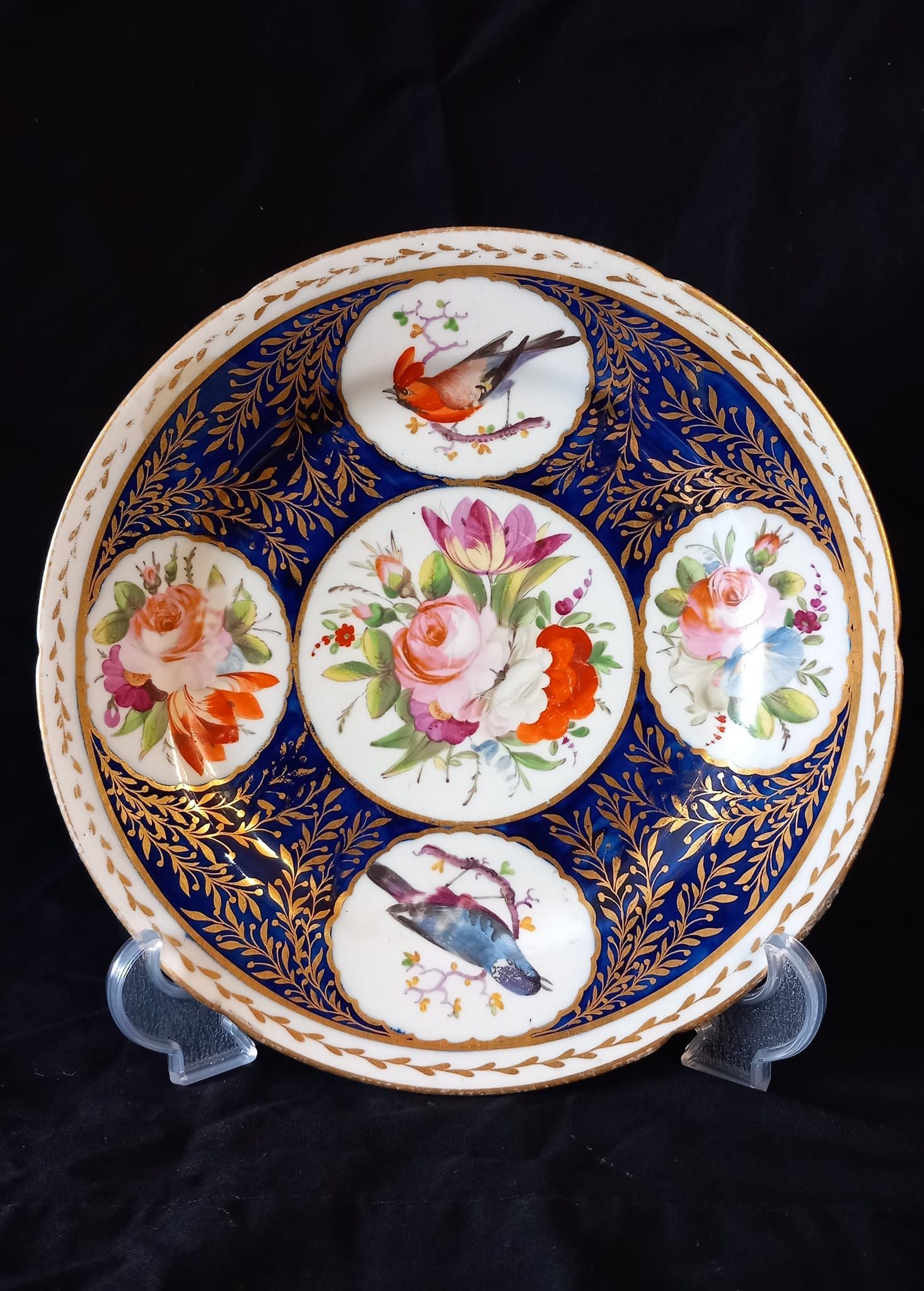

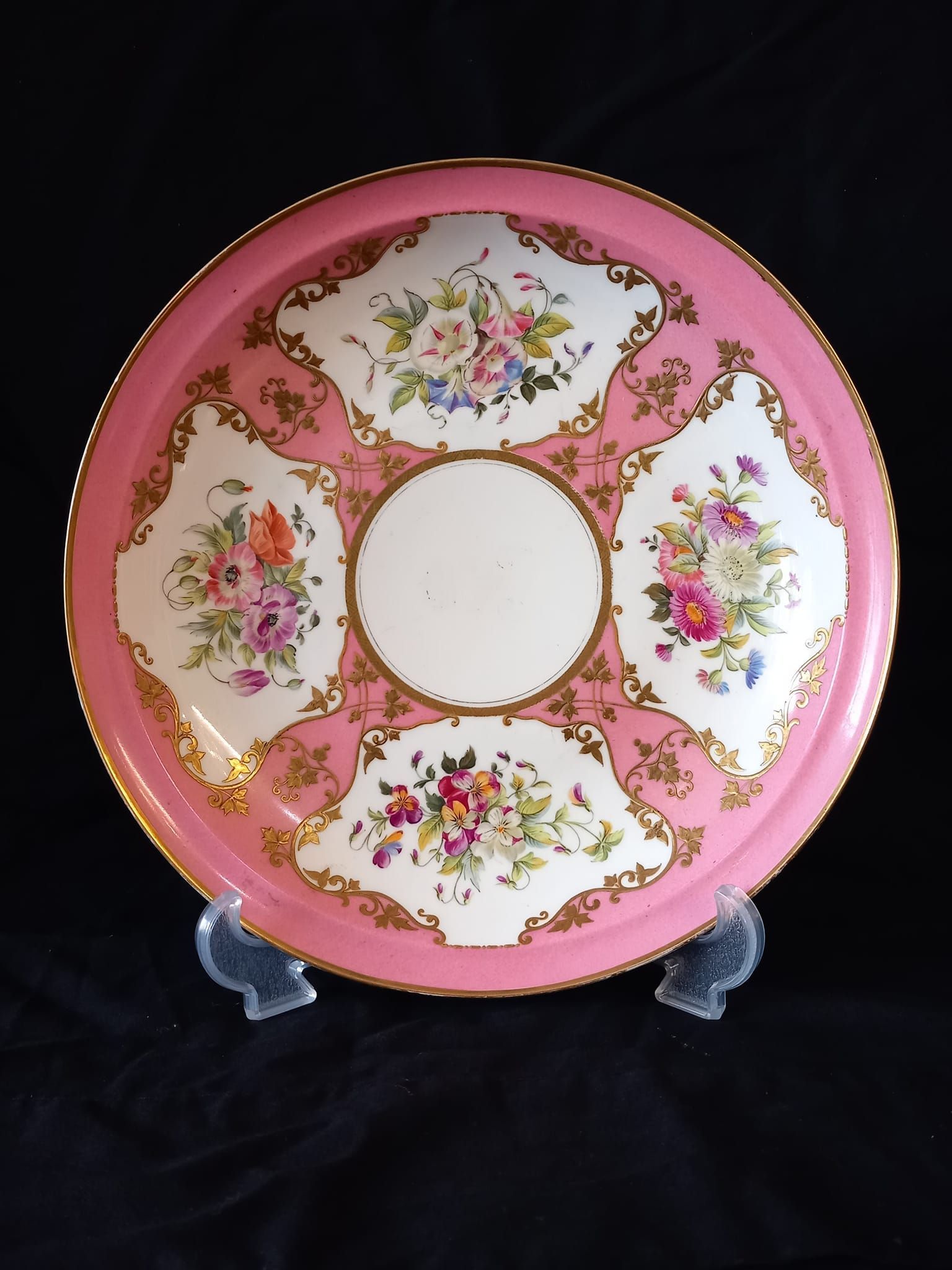
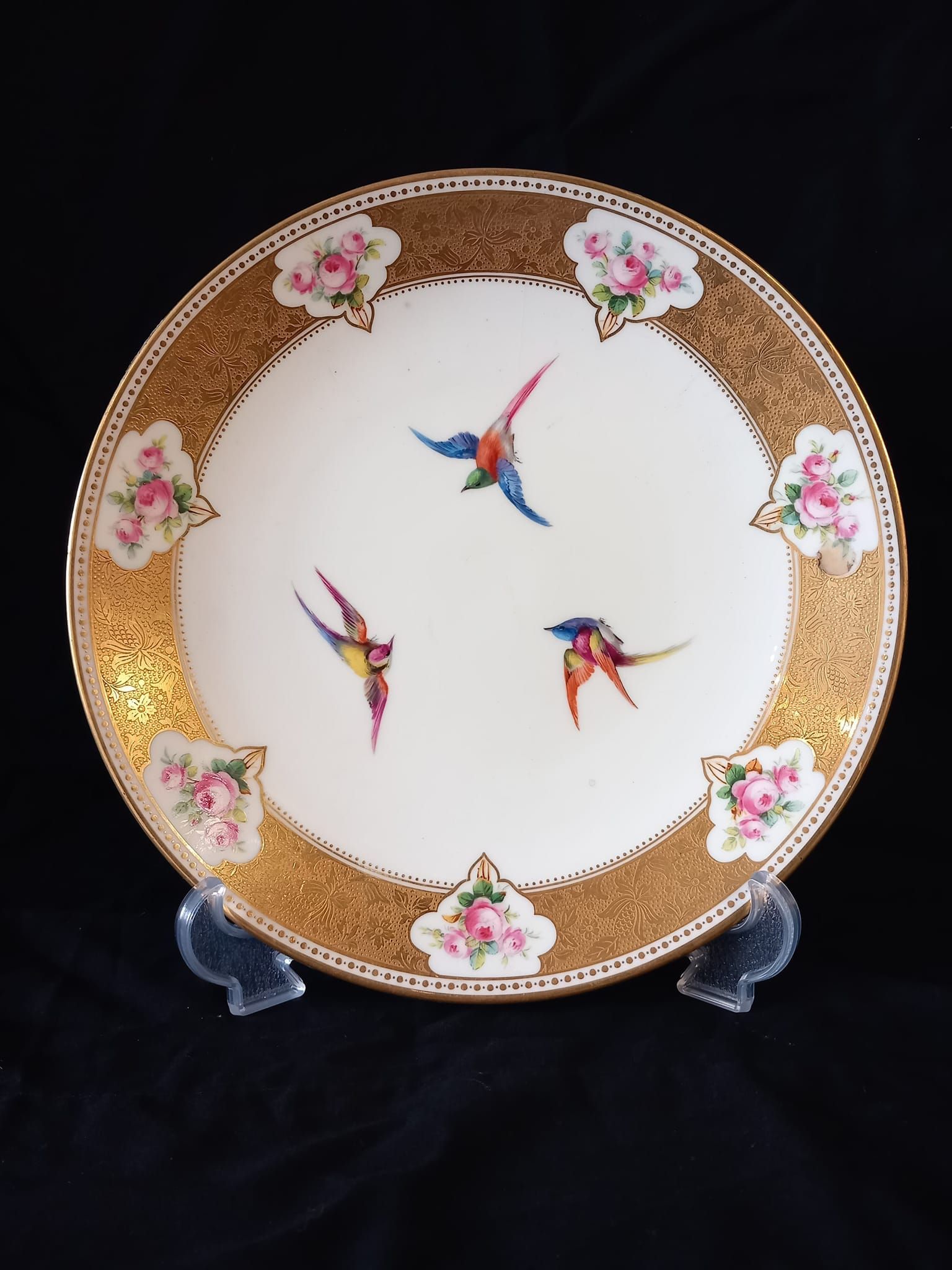
Picture Gallery:
Please Scroll Down: We are so lucky to have so many beautiful items and only limited space on this website, this means we can't put lot's of photographs up, just enough to wet your appetite. So if you would like more photographs of an item, or any information about it, please don't hesitate to ask. Just pick up the phone and call us on 01492640789, email us at snowdoniaantiques@gmail.com or see the contact panel below and we will only be to happy to help.
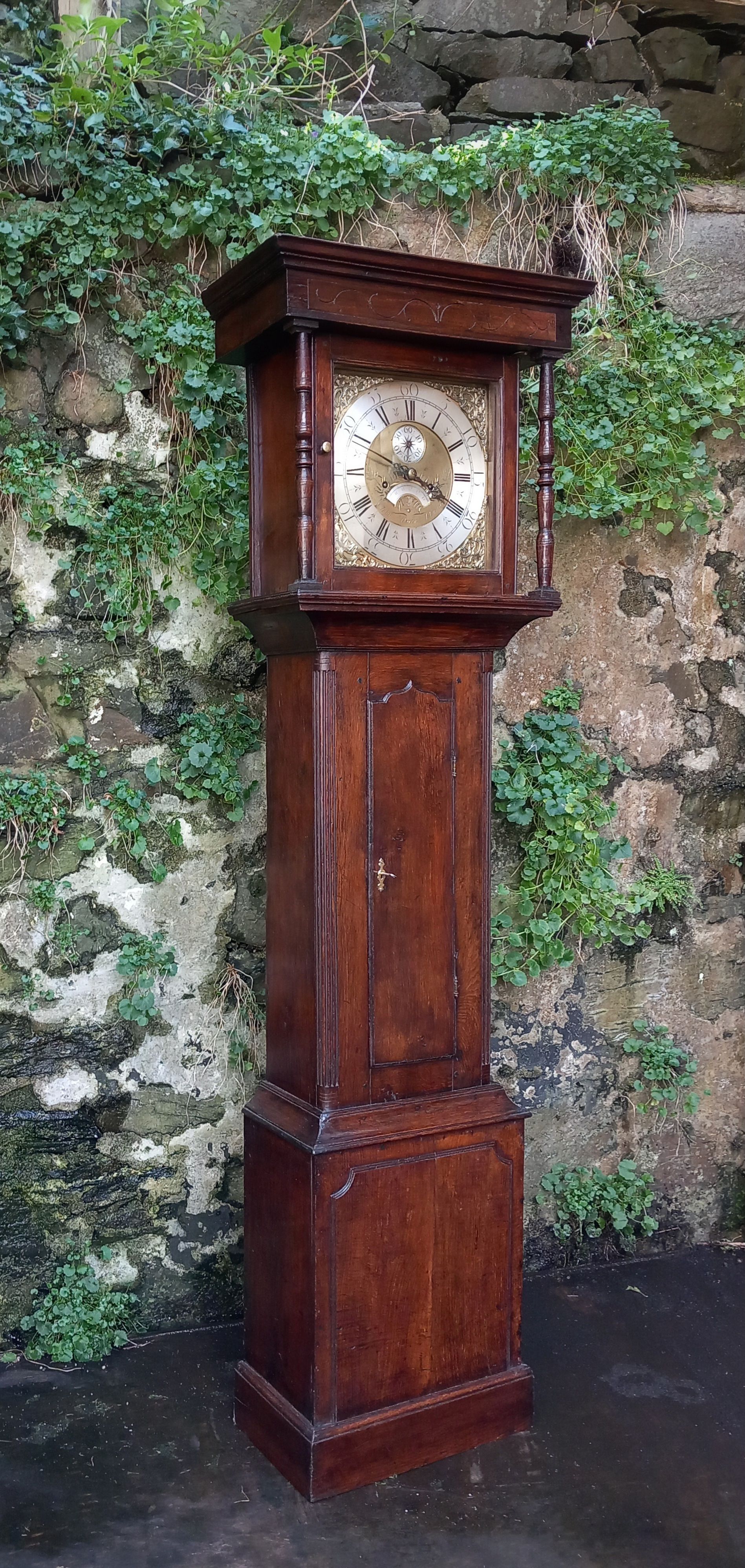
A Mid 18th Century Oak Longcase Clock by John Owen of Llanrwst. Circa 1755-60.
John Owen started the business of clockmaking in Llanrwst around 1740, and for around 100 years the tradition was carried on by a family members right up untill the mid 1840's where the last Owen of Llanrwst's clock where produced.
Here we have a beautiful example of a cottage clock by John Owen. The name cottage clock comes from the sizes of the clocks these where only small clacks and were made for the small cottages that dotted along the Conwy valley.
This particular clock shows all the hallmarks of a traditional John Owen, but with some unusual features such as the lunar date aperture, the beautifully engraved 12 inch dial being brass with silvered chapter ring, seconds disc and date wheel holds both Arab and Roman numerals, and shows off the engravers work at it's very best. The works and dial is set inside a stunning solid Oak case, the timber for the case being felled from the forest above the town, seasoned and turned into a beautiful clock case with a wonderful colour and patina. The design is very provincial but exactly what you would come to expect from John Owens case maker, the main door profile is beautifully shaped and flanked by reeded columns above a squared base on a plinth. All in all a fantastic piece of Welsh history created by arguably the countries greatest clock maker, using materials from the town and the surrounding area.
Size: Height 191cm x Width 49cm x Depth 26cm
Price: £5,500
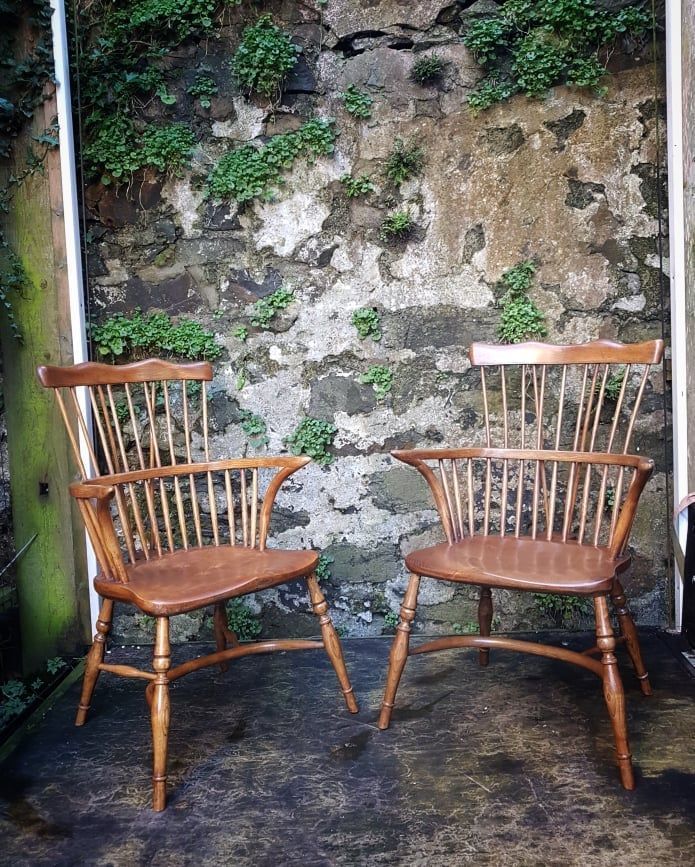
19th Century Elm Comb Back Windsor Caver Chairs. Circa 1860.
This beautiful pair of high back Windsor chairs are stunning to look at and Oooohhhhh so comfortable. The chairs are of solid construction with bobbin turned legs and crinoline connector which shows the classical design off perfectly and also being Carvers have arm rests with a swept supports leading to a combed back and swept head rail all in all stunning examples of the period in which they were made. I must admit I do have a soft spot for a Windsor.
Size: 98cm high x 61cm wide x 59cm deep.
Price: £1,250

A Dutch Delph hand painted Blue and White Miniature Mantle Clock Circa 1880.
It's the firing process that makes this stunning little mantle clock so highly prized. The creation of Porcelain being kept secret by the Chinese for hundreds of years before being mastered by European makers at the turn of the 19th century.
This beautiful blue and white miniature was made in Germany in the late 19th century, the theme being star crossed lovers out for a romantic stroll.
Sizes: 42cm high x 12cm wide x 9cm deep
Price: £475
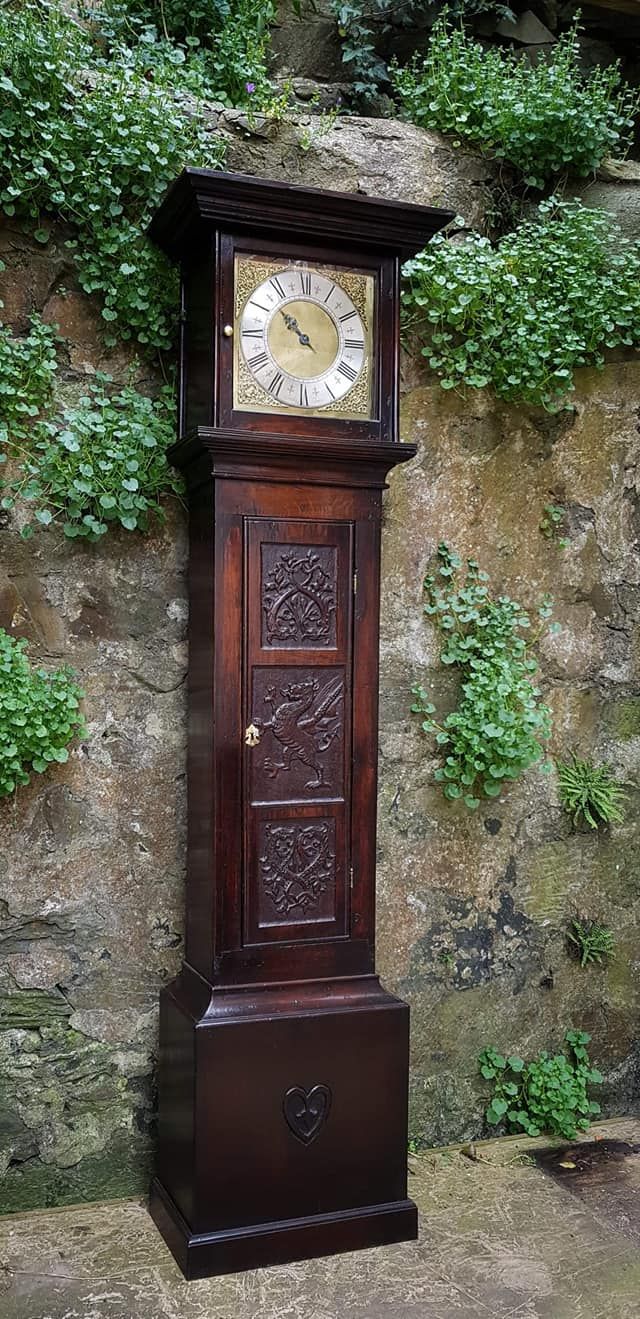
Oak John Owen Llanrwst 30 hour Longcase Clock, Circa 1743.
In 1743 John Owen had just started to create the beautiful longcase clocks which would go on to make him and his family world renowned , with the name of Llanrwst firmly being stamped onto the world of clock making.
This stunning 30hour clock is highly unusual in the fact that there has only ever been three recorded examples of a John Owen of this duration, and no other clock has is seen as being of this age. This 30hour clock is what we like to call a labour of love clock, needing to be wound every 30hours, you'll find that those with this type of clock, not only know about the intricate workings of the piece but also have the understanding, that once a day its chain to drive it will need pulling. The clock can be accurately dated not what you see on the outside but by the intricacy of the inside of the works as it is where John Owen practiced his engraving, this shows the date, John's name, his father's name and his age with an assortment of numbers. On the reverse of this John has attempted do engrave a flower. This panel can only be seen when the works has been dismantled. The clock is fascinating and a wonderful example of John Owens work.
Size: 198cm high x 44cm wide x 24cm deep.
Price: £4,300
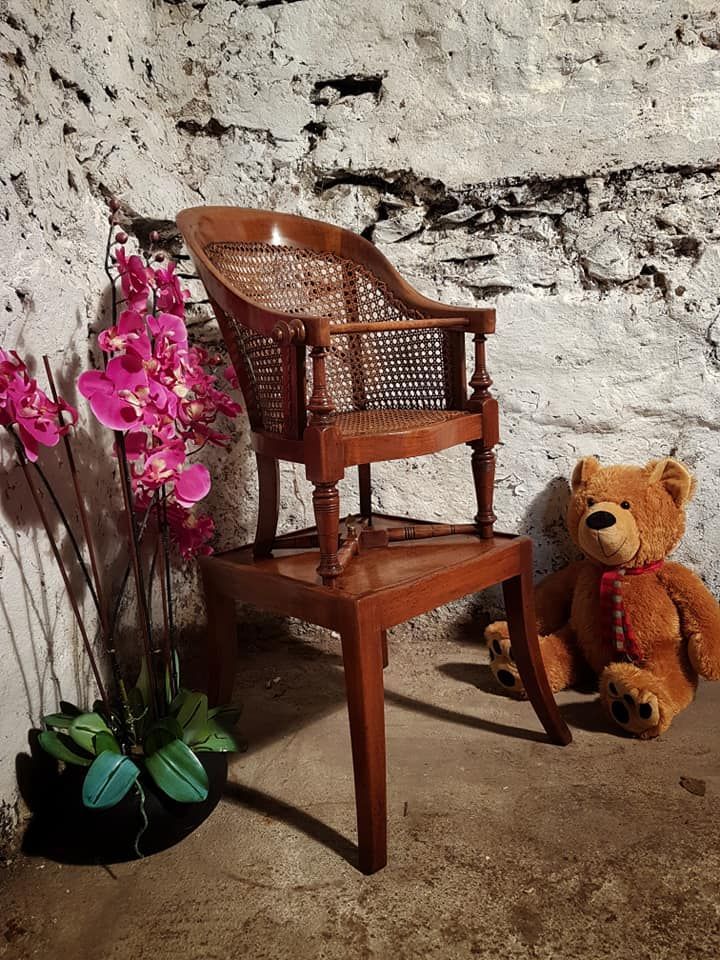
A Regency Walnut Rattan Childs Chair. Circa 1820.
Now this has to be one of my personal favourites and although it is 200 years old, it's rattan woven child's chair is still in perfect condition. Originally known as child restraining chairs or as we know them. "Child's Highchair" this beautiful example is made from Walnut which has that rich warm glow which you would expect with this timber. The chair separates from the table for when the child became a toddler allowing them to have more freedom.
Size: Overall 91cm high x 40cm wide x 40cm deep.
Price: £895.
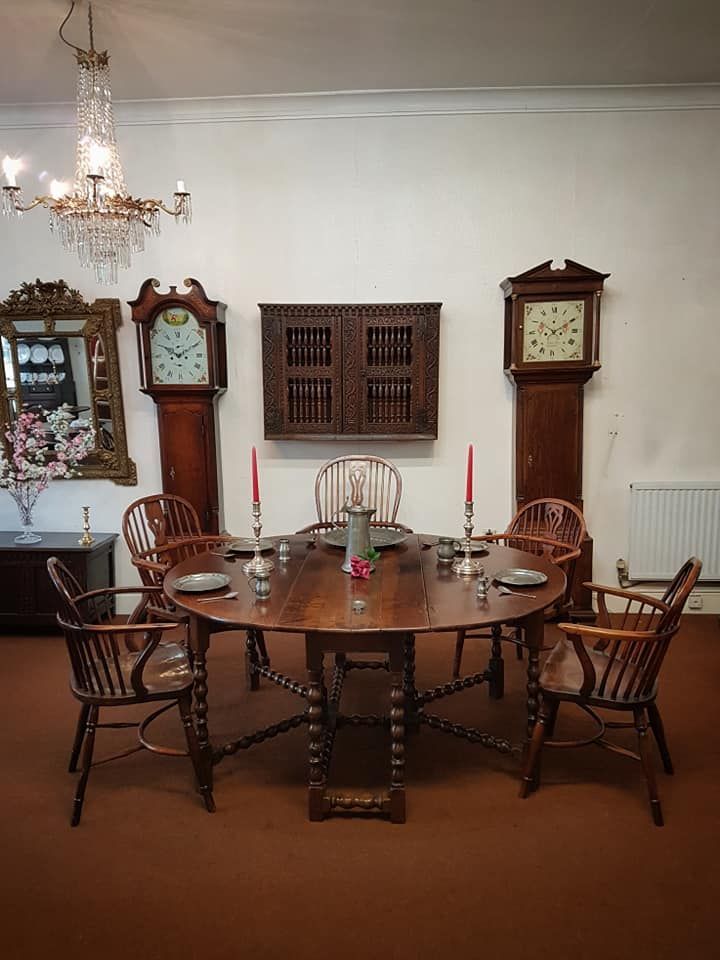
Oak Gateleg Dropleaf Table. Circa1730.
There's always something magical about Christmas, it's more than turkey and present's, to me it's the gathering of family, a time to laugh, sharing and spend time with loved ones and where better place to spend it than around this beautiful Oak bobbin turned legged table.
Tables of this age are all special, to have lasted 300 years and still be doing what they were designed to do all those years ago, whilst looking stunning with the mellowing of age. This stunning table can easily seat six with a snug eight at a push, Made from solid Welsh Oak it's unusual four splayed leg construction makes for a solid piece with the possibility of being folded down for easy storage when not in use. The rich warm strong Welsh Oak finish would suit any home and is a fantastic piece of practical history.
Size: Diameter when leaves are open 162cm (53cm when closed) x 72cm high.
Price £3,500.
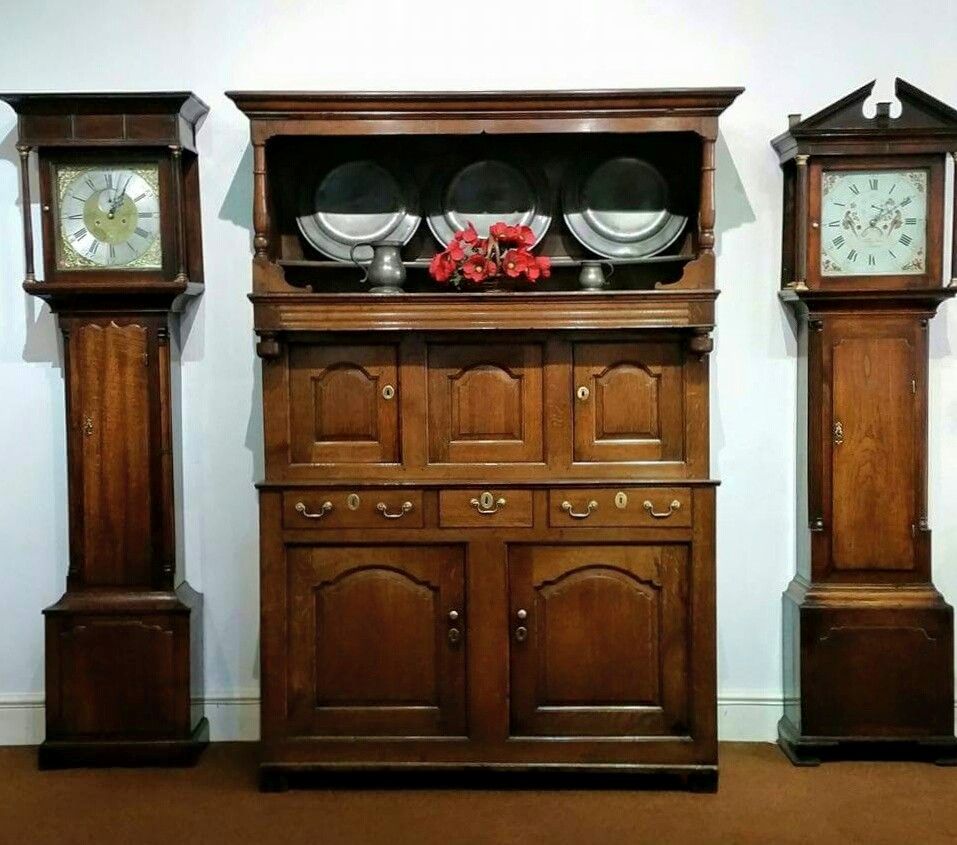
Welsh Oak Cwpwrdd Tridarn. Circa 1740.
Nothing is more iconically Welsh than a Cwpwrdd Tridarn, It strong lines and beautiful colour just adds so much to the overall impressive design. The canopy top sits above a block centre with three shaped fielded panel doors, the centre door being a false compartment with hidden drawers. above a block base with drawers and cupboards. The Cwpwrdd Tridarn or three tire court cupboard has been said to be the for-runner to the Welsh Dress, this can easily be seen as they are both large solid pieces of furniture with the same practical use. Mainly made around the Caernarfonshire area, comprising the valleys that run from the centre of Snowdonia the colour of the timber used comes from the ground it was grown in, with darker pieces coming from a more boggier area. A large number of cwpwrdd tridarn still survive to this day so you can see they were built to last, using traditional joints and methods, since they originated in an area where there are very few if any mansions, they must have originally been made for larger farmhouses in the area.
Size: 210cm high x 142cm wide x 52cm deep.
Price: £4,500.

Oak 18th Century Joint Stood. Circa 1720.
Joint stools were one of the most versatile pieces of furniture and were used for a variety of different purposes. They came in varying sizes and heights and saw different uses accordingly, being kept to one side within the room these stools could be brought out quickly and allow people to sit with little or no trouble. Also known as coffin stools they would come in pairs some being used to hold the coffin during a wake, one at the foot one at the head, yes I know this is somewhat macabre, but they were extremely practical things and as I mentioned before where used in a number f different way. You would think these days they would have fallen out of fashion but they are extremely popular and ones of this are are extremely rare.
This particular one has a top rail with a central run-moulding which is beautifully shaped connect through columnar turned legs joined around the base by a heavy plain stretcher.
Size: 59cm high x 51cm wide x 30cm deep.
Price: £1,350

Early 18th Century Wick Stand. Circa 1710.
There's a simplicity to a Wick Stand that typifies the 17th and 18th Centuries . Beautiful yet practical it does everything that's asked of it, the candle burning brightly allowing for the wick to be lit so that other candles can in turn be lit. If the wick goes out you can always return to the first light and when all the other candles in the room are lit, the wick then can be blown out and returned to its stand.
This beautiful little piece looks absolutely stunning, made from iron with a twisted centre leading up to the wick gripper and candle cup it all stands on a fruitwood chamfered block.
Size: 33cm high x 13cm wide at the block.
Price: £210.
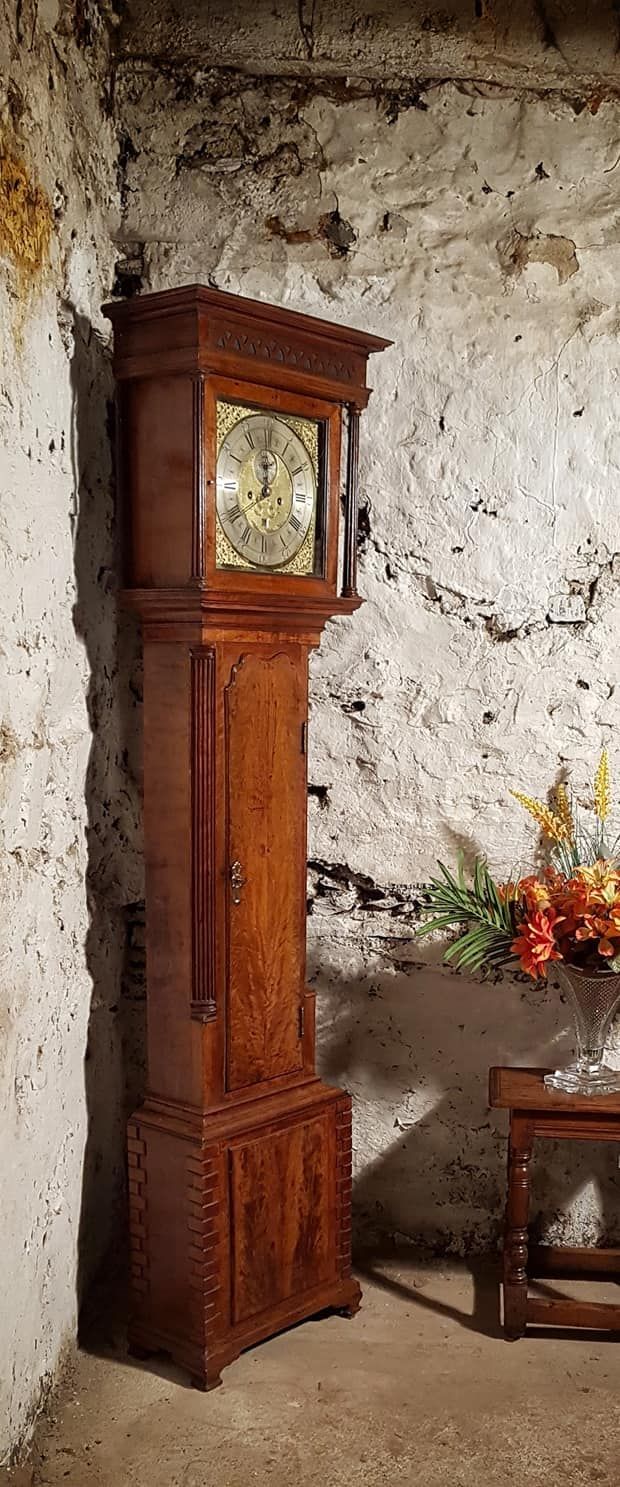
Walnut 8 day longcase clock by John Smith of Macclesfield. Circa 1760.
John Smith was a prolific clockmaker at a time where clockmaking was going through great changes and people like John Where turning it into a cottage industry. This example of his work just exudes the classic lines and beauty of the Georgian period, the choice of Walnut for the case reflecting the refinement and wealth of the time. The works being that of an 8 day duration, striking hourly on a single bell has a stunningly hand engraved dial, the silvered chapter ring holds both Roman and Arabic numerals and also has a sunken seconds aperture and date aperture with a silvered date ring. All this sits with in a truly elegant Walnut case with a blind fretted flat top hood which has turned reeded columns, flanking a glass door.
The main body of the clock has a shaped profile door flanked by reeded quarter cut columns above what is known as a Liverpool brickhouse base standing on Ogee bracket feet. This clock ticks all the boxes and is in full working order so you'll never have an excuse to be late.
Size: 209cm high x 48cm wide x 24cm deep.
Price: £4,500.
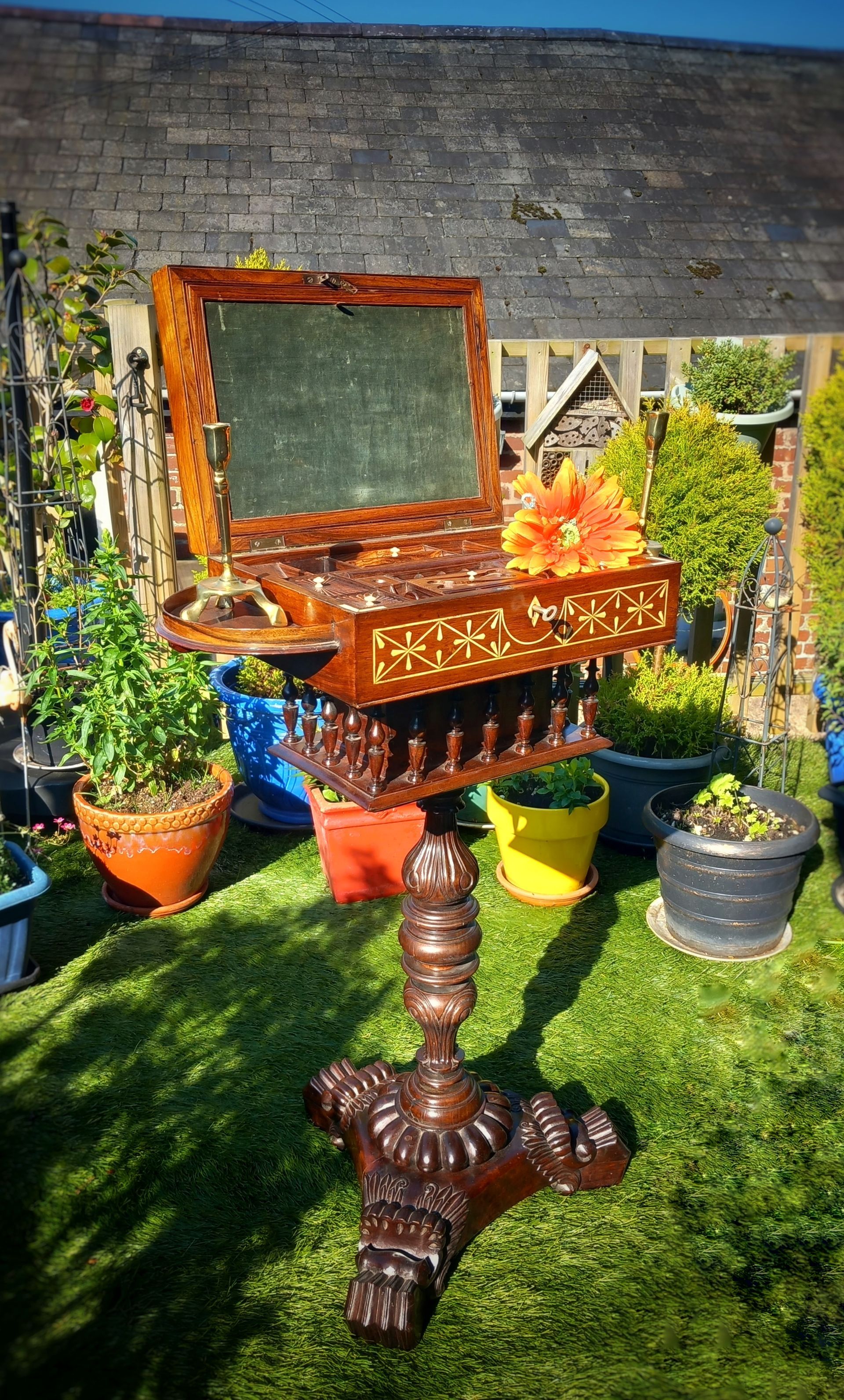
19th Century Rosewood Workbox. Circa 1830.
Over the Centuries English furniture makers have been heavily influenced by cabinet makers from foreign lands, even the great man himself Chippendale, with his range of Chinese and French style influenced pieces it not a knew thing. Here we have a beautiful Regency Rosewood Workbox made in Britain but influenced by the working of Indian furniture makers.
The beautifully inlaid box section at the top has twenty three individual sections where items can be stored, some of them secret drawers. All this above a turned gallery, standing on a turned and shaped central pod which leads down to Lion paw feet. Once again a practical and beautiful item which wouldn't look out of place in any home.
Size: 81cm high x 59cm wide x 28cm deep.
Price: £850.

Mid 18th Century Portuguese Fruitwood Candlestick.
Now size doesn't matter here at Snowdonia Antiques but quality really does and the little Fruitwood candlestick. For hundreds of years Candlesticks have been used to hold candles in place, from ones that have cups to those that just have a spike there job was quite simple, hold and give light.
This particular one is stunning, if it where made of brass or a metal the the cast would have been so intricate but this one has been made from fruitwood, a soft material to use turn and carve and this one really shows the art of carving at its very best. The candle sits in a cup with a spill catcher just below it to stop the wax from burning the hand if its being held. Practical yet beautiful.
Size:
Price: £265.
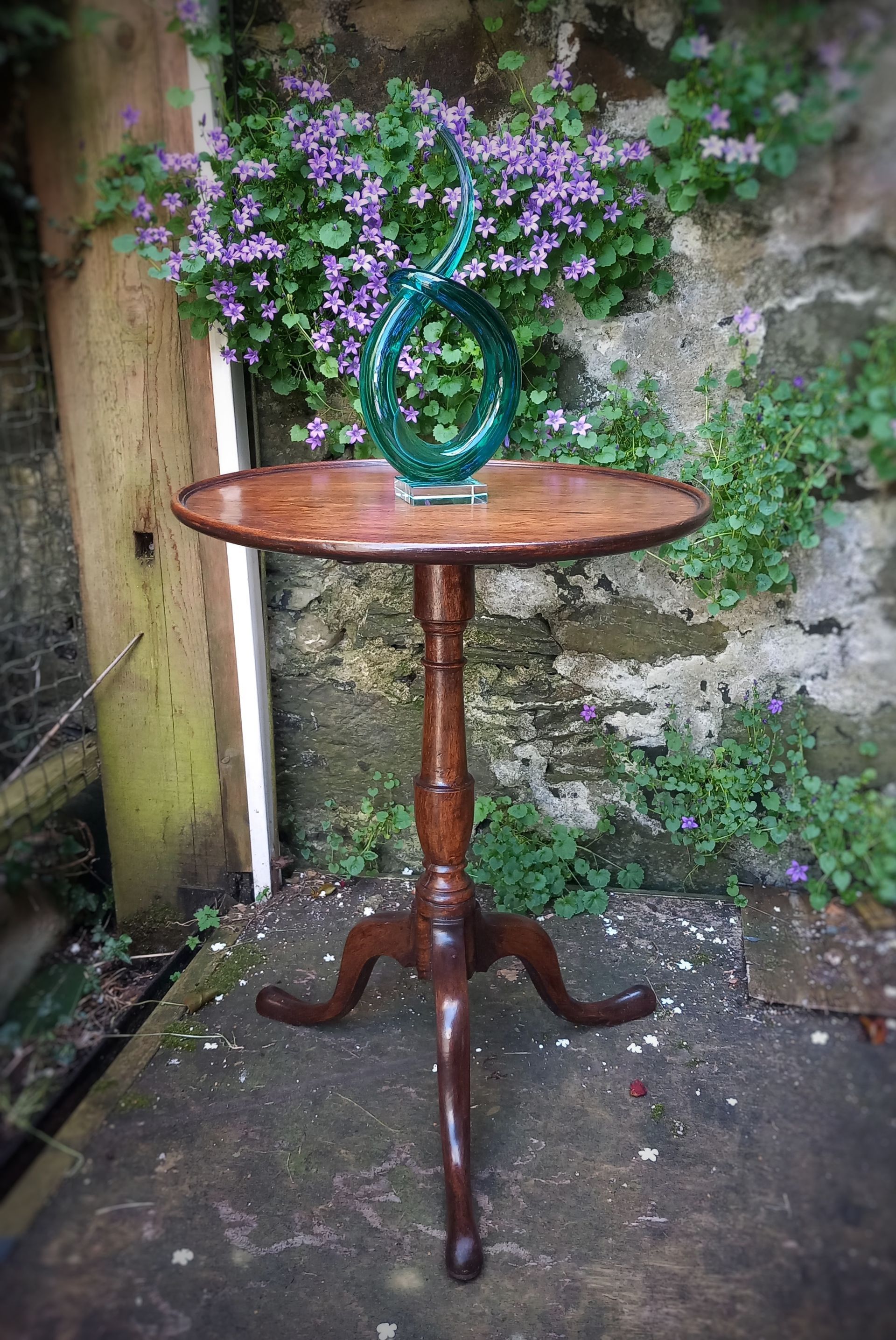
Georgian Oak Tilt Top Wine Table. Circa 1790.
Both practical, and beautiful this stunning little tilt top side table would grace any home. The mellow rich colour of the Oak on this table would work well with any décor contrasting beautifully with a white background or as you can see from the photograph above blend in subtly with a busier surrounding.
The tilt top has a catch underneath which allows the top to lift to make it easier to store when not in use, it's beautifully cupped edge top is of one piece and just shows the quality of the cabinet maker. All this is supported by a stunningly turned gun barrelled centre known as a gun barrel because of it resemblance to a cannon of the time, this all leads down to three shaped, splayed legs.
Sizes: Height 73cm X Diameter of top 54cm.
Price: £875.
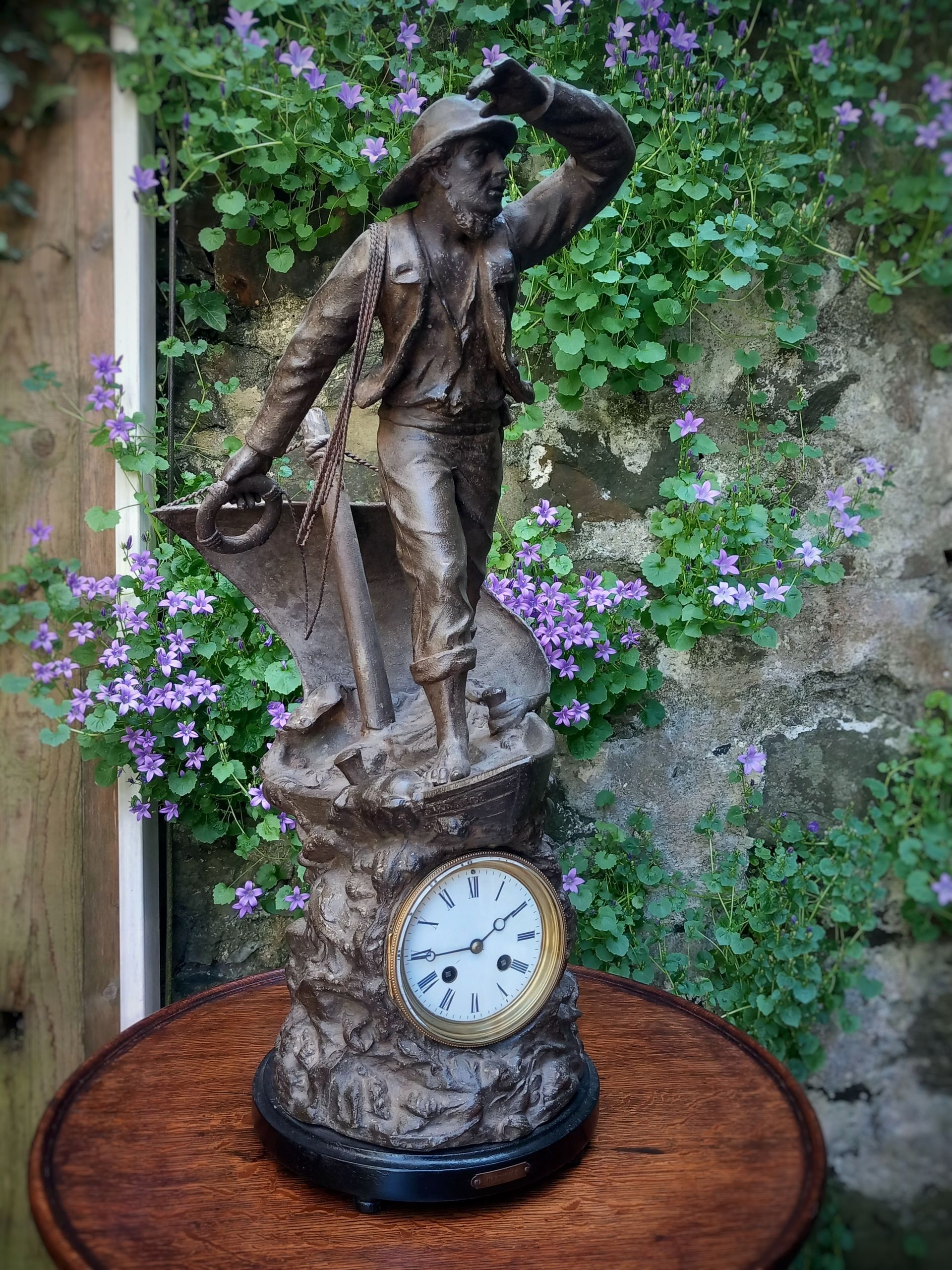
The Rescue. Circa 1870.
Here we have rare figural mantel clock in a nautical theme, this clock is by R&C of Paris and London and is entitled 'Rescue'. According to Charles Allix (in his Carriage Clock book), this firm was founded in Paris in1848 under a different name and added a branch in London in 1857. Then in 1867 the branch became Richard & Co. of 24 Cannon Street, London. In France, this would be Richard et Cie. Brian Loomes in his books says that the London business lasted until 1881 so this works would have passed through his shop around 1875.
This particular clock is Spelter, spelter is made up of copper, zinc and lead instead of the better bronze which made it more affordable to the average person allowing them to have quality in their homes without the price tag this particular figure shows all the quality of it's production with fine detail in the ship's rope and bellowing sails. The clock strikes both on the hour and the half hour.
Sizes: Height 66cm x 28cm in Diameter.
Price: £725.

19th Century Mahogany Barometer by Wells of Barnet. Circa 1805.
Here we have a four panelled barometer by Edmund Wells a Barnet instrument maker of the highest quality. Evangelista Torricelli made the first mercury barometer in the 17th century. The first instruments made were of the stick type, but the "banjo" shape barometer became popular with the invention of the wheel barometer by Robert Hooke in 1665. The barometer pictured above is a beautiful example of Wells work, his name adorns the bottom panel with the weather settings above and a detachable thermometer above that. all this is enclosed in a stunning flamed Mahogany case, this barometer truly is a touch of pure class.
Sizes: Height 101cm x Width 35cm.
Price: £975